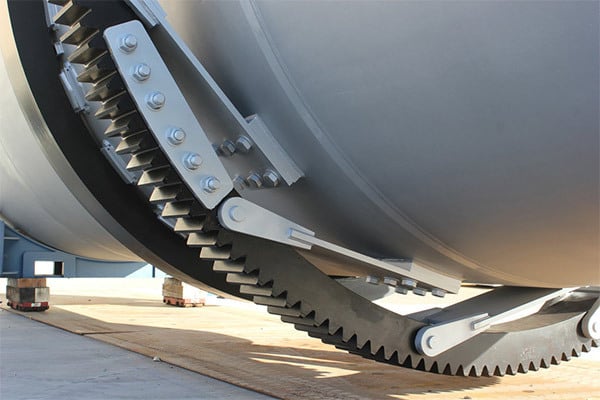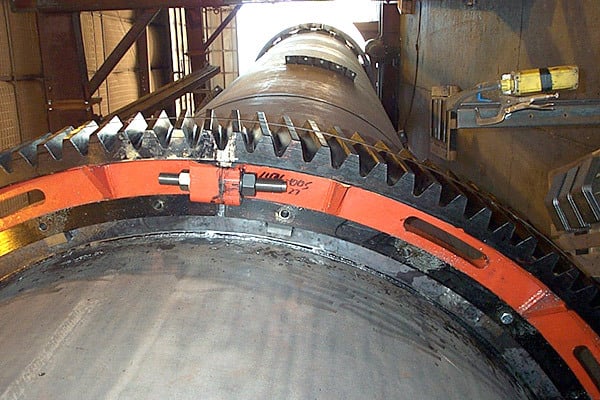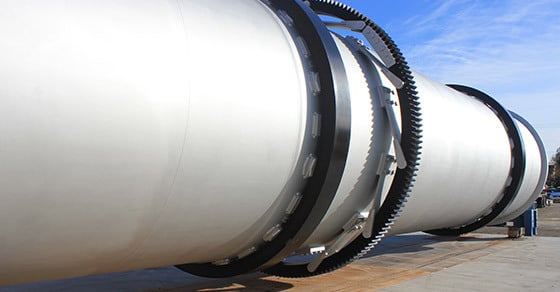Heavy-duty and built for high-horsepower jobs, the gear and pinion drive assembly is one of the most popular rotary drum drive assemblies on the market. In utilizing a gear and pinion drive, one must decide how the gear portion of the assembly will be affixed to the drum – a decision that can significantly influence the service life of a high-quality girth gear, making proper selection an important decision.
Here’s a look at the two primary types of girth gear mounts and factors to consider in choosing between them.
About Girth Gears
Girth gears require a mounting system that promotes structural integrity and provides support to the gear as it rotates under varying load conditions and in many cases, thermal stresses. As such, a solid girth gear should exhibit the following qualities:
- Structural integrity and strength
- Concentricity
Girth gears are typically mounted using one of two styles: spring mount or flange mount. Both options offer an effective mounting system, but they each have their own unique advantages and disadvantages.
Spring-Mounted Girth Gears

Spring-mounted girth gear
The spring mount style is the most commonly used and consists of a rectangular gear and spring arm spokes as shown in the image above. This mounting system works by allowing the shell to expand and contract under the gear.
The flexible nature of spring plates are responsive, allowing the drum to expand and contract without infringing on the structural integrity of the gear.
This spring-mount style is also significantly less costly than the flange mount. However, it is much more difficult to change out or flip compared to a flange-mounted girth gear. It is also more challenging to install.
Flange-Mounted Girth Gears

A flange-mounted girth gear
The flange-style mount consists of a gear with a machined flange and a flange welded to the drum shell. The gear is then bolted to the flange on the drum shell.
The flange gear mount style is significantly more costly (nearly double) than the spring gear mount style, but it does offer a few advantages over the spring style.
First, it is much more easily “flipped” for maintenance purposes, reducing the amount of time and labor required. It’s also easier to install in the field; manufacturers can mount the gear in their shop, remove it, and reinstall it in the field with minimal effort.
The disadvantage to the flange-mounted girth gear, however, is that it is not flexible in terms of thermal expansion and contraction; the drum temperature limit for a flange-mounted girth gear should not exceed 350° F, so it can be an option for low-temperature rotary dryers and coolers. When thermal expansion is a concern, rotary drum manufacturers rely on the spring mount style.
Deciding Between a Flange and Spring Mount
The decision between the two first depends on whether or not thermal expansion will be at play, which in most cases, would favor the spring-style mount.
If thermal stress is not a concern, the choice is one of balancing cost with maintenance and installation time and labor.
Conclusion
Choosing the appropriate gear mount for a given rotary drum application is the first step in promoting a long girth gear service life. While the flange-mounted girth gear has some advantages, it is not appropriate in all production settings, particularly when dealing with thermal expansion or contraction. When thermal expansion comes into play, the spring-mount style is the best approach.
As the leading provider of custom rotary drums, FEECO can not only provide new or replacement girth gears, but we can also advise on the most appropriate mounting style, as well as assist in the changeout. For more information on our rotary drums or parts and service, contact us today!

